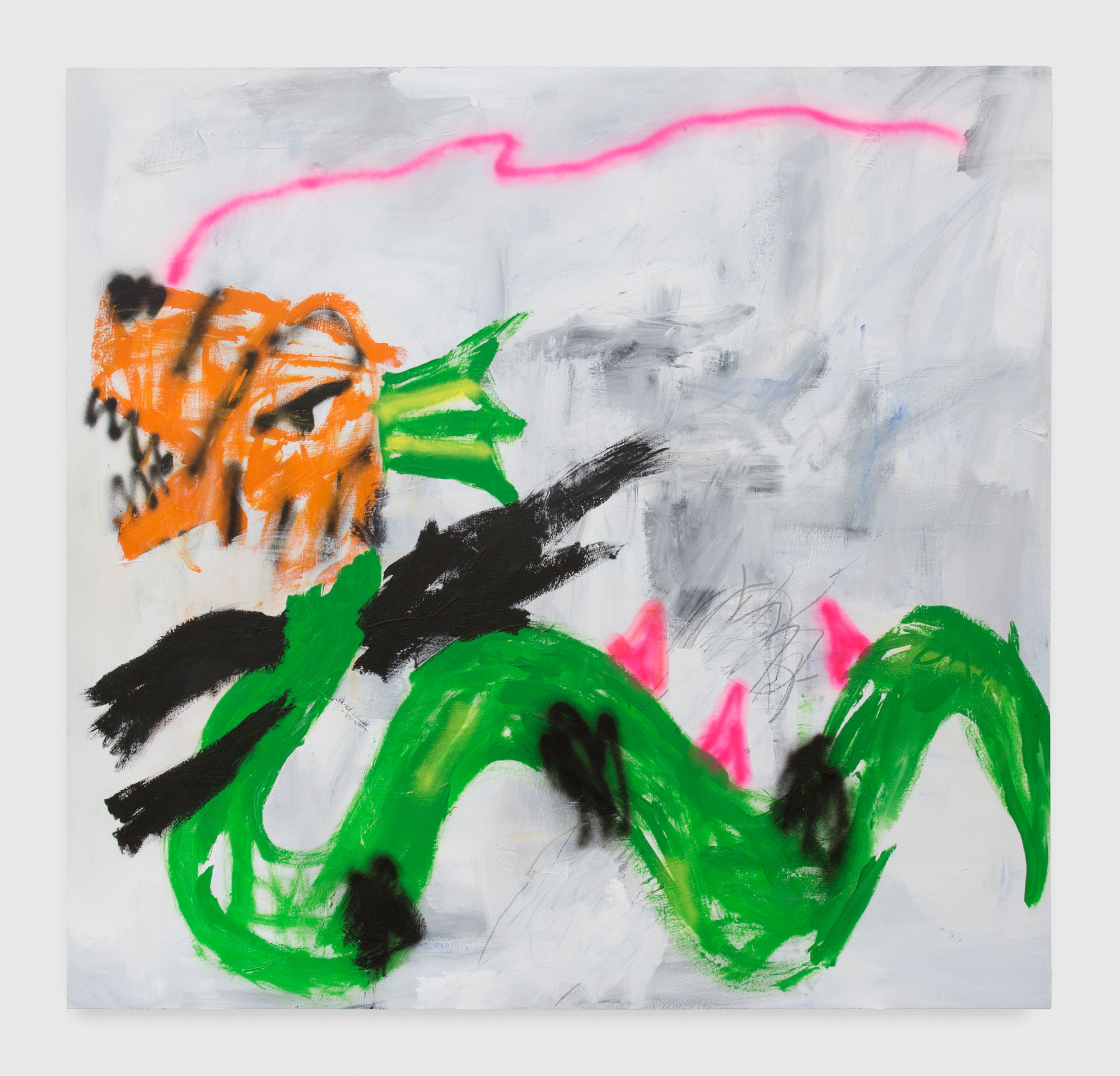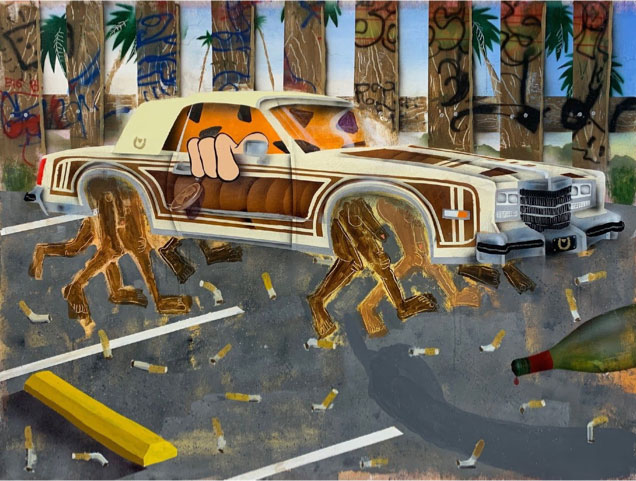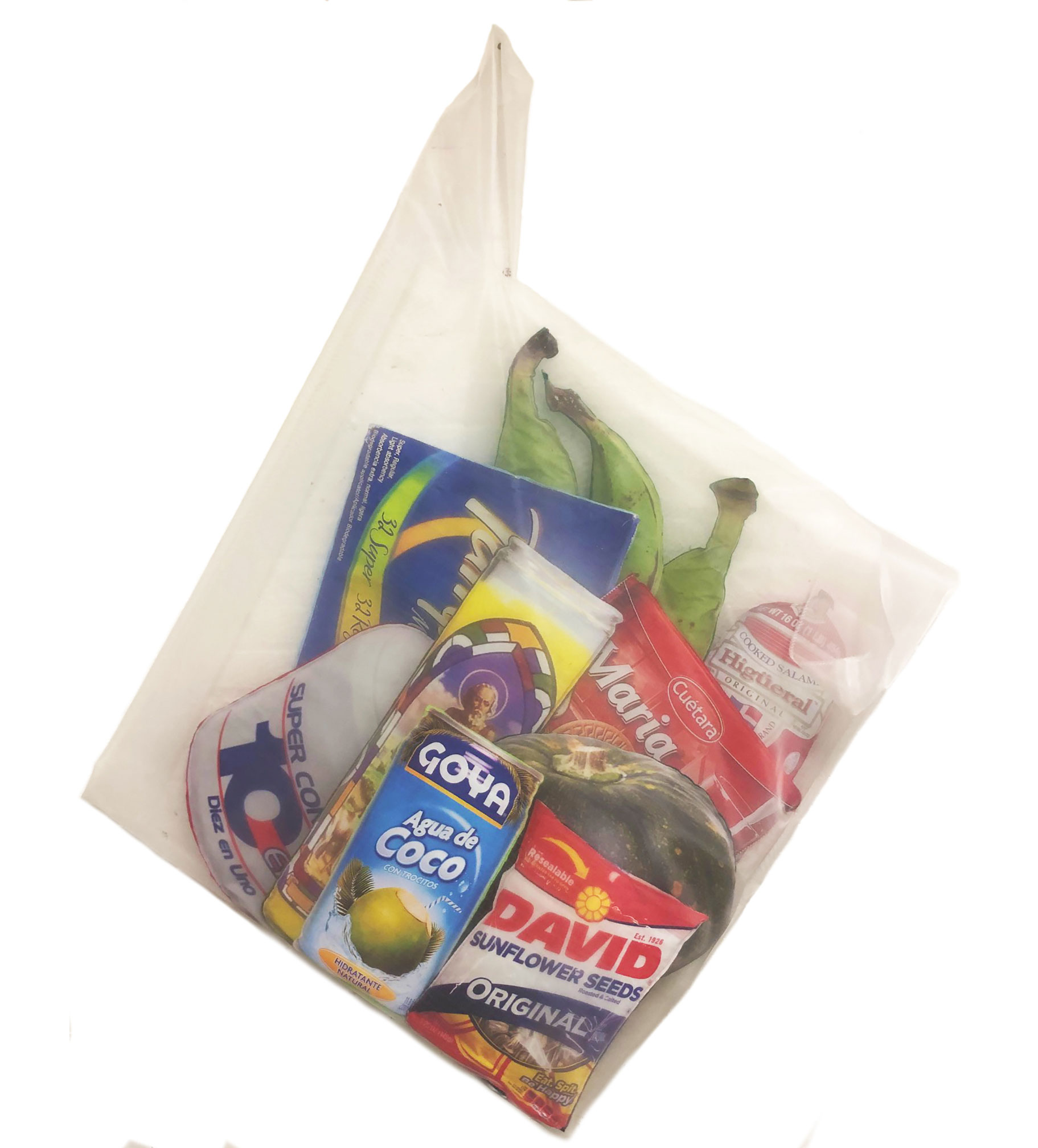
This past Saturday evening, gallerist Jeffrey Deitch and artist and curator Nina Chanel Abney welcomed droves of excited fans and artists alike for the opening of the Los Angeles edition of “Punch” at Deitch’s Hollywood location. After the first iteration of the show last fall in New York was such a hit, the two decided to do it again—this time on the West Coast, in a much larger space and featuring more LA-based artists. The large, open space buzzed with energy, and the gallery’s skylights and windows let in the last few minutes of the day’s natural light, catching the reflections of pieces on view. “Almost every work in the show has some pop aspect, and deliberately has a punch to it,” Deitch says. “The art is lively and engaging. Most of it is pretty colorful, and it represents a very contemporary sensibility.”
We spoke to Deitch and Abney about the origins of their relationship and the evolution of “Punch,” on view through August 17.
How did the two of you meet?
Jeffrey Deitch: I’ve been following Nina’s work really since the beginning of her career almost 15 years ago, and we got to know each other when I commissioned her to create a mural for an outdoor museum we established on Coney Island. That was a few years ago, and the mural is a masterpiece. It’s still there.
Nina Chanel Abney: Over the course of the years we’ve always stayed in touch.

How did the original “Punch” exhibition in New York come about, and why did you decide to bring it to LA? How have you both worked together to bring this show to life and what makes you a good team?
Deitch: Two years after we met, Nina came to visit and said she had an idea for a thematic show that she’d like to present, and she’d like to present it with us. I said absolutely because I knew it would be great and I fully trusted her. We opened the first version of the show in New York City last fall, and it was so well received and we had such a good time with it that we decided we had to take it to LA. This is “Punch LA,” and it’s larger and more ambitious than the New York version. We added more LA artists, and artists made larger works because the space is larger. Then there’s Nina, who is remarkable. Not only is she someone who can make a great painting like the one featured, but she has the capacity to have this curatorial vision and this great social network around her.
Abney: I collect work myself, and I’m friends with a bunch of artists. I was posting artists that I like on my Instagram, and I noticed a lot of people direct messaging me and asking me about them, so that’s how I decided to curate a show. I met with Jeffrey and said, “I have a crazy idea,” and he was on board, so that’s how it started. Jeffrey is always supportive of crazy ideas and doing all kinds of stuff in the gallery space that a lot of galleries wouldn’t do. The combination of artists that I picked typically are not shown together in exhibitions, but I knew he would be up for something different. I haven’t had too much exposure in LA—I had a museum show not too long ago, but it was a lot of borrowed work, nothing new, and I really wanted to make a splash in LA and bring all the other artists too. A lot of people have already evolved from the last “Punch.”
This show is very diverse, not only in the different depictions in the paintings, but also in the artists featured. Why is that important?
Deitch: Many of the artists are African-American; many are women, so it reflects the new makeup of today’s leading art world. What’s especially remarkable is that there is a personal network here too because Nina is friends with most of the artists in the show. Last night, we had a dinner for all the artists who are here plus the artists’ friends, and we had a really great sense of community.
Abney: I can’t think of too many exhibitions that would have this diverse group of artists, but Jeffrey’s known for supporting stuff like that. I think people go to Jeffrey to expect something more innovative.

Do you think the show will be received differently in LA than NY?
Deitch: In New York, people are accustomed to large group shows like this—it’s actually a summer tradition. Our last show was in the fall, but a lot of the galleries that have a roster of artists have solo shows during the main season, and they have thematic group shows in the summer. We have group shows all the time, and of course there are a number of group shows in LA galleries, but an ambitious show like this I think is special for a commercial gallery in LA. People are maybe more isolated during the daytime here. In New York, there’s a lot of encounters on the street. In LA, while there are more than there used to be, people still need to come to events like this to connect—it’s very important. I’ve noticed that openings are quite lively here, whereas regular gallery hours, sometimes an hour goes by and there’s no visitor. In New York, you have a pretty steady flow.
Abney: The show is a lot different than how it looks in New York, but I kind of like this one a little better. This space is huge, and it’s laid out much differently, so it just presented another fun challenge for us when we were choosing where to hang the work. Honestly, I have no idea what the response will be, but I’m really curious.
You have described the show as “defying traditional expectations” of contemporary figuration. How do you think “Punch” does that? Are there any specific pieces that you think do that particularly well?
Deitch: First, we can look at Nina’s piece. There are many approaches here. Some artists, like Arc Niles, are classically trained. He went to the Pennsylvania Academy of Fine Arts and the New York Academy of Art, and you can see he learned classic techniques of how to paint a figure. Others come from a different place, looking at cartoons, science fiction sources or even assemblage approaches—it’s a diversity of approaches to the figure.
Abney: I feel like almost everyone stands out. For example, Austin Lee creates his work basically in virtual reality. I like Tschabalala Self’s work, as well. Everyone is doing something kind of different and new, which is exciting.
Many of the artists featured in the show grew up in the digital age. Have developments in society and culture altered our perception of contemporary life, and is that reflected in the pieces in the show itself?
Deitch: The answer is yes, but human nature remains pretty much the same. There are some artists like Austin Lee, who is clearly immersed in digital language—the language of video games—whereas, an artist again like Arc Niles, that’s a much more classic composition, but it’s still very fresh. You don’t typically have a figure with hot pink hair and beards and those other figures crawling around. He is usurping a traditional academic approach to painting.
Abney: For myself and I’ve also noticed in a few artists, it’s almost as if their process is affected by it or it influences some of their content. I’ve made works on the computer, and I think that some of the artists are using digital means to make the work also.
Nina, as an artist, how has curating these shows affected your practice?
Abney: It’s fun to see all aspects of working on a show— hassling the artists with questions like, “How’s your painting coming along?” when I still have to work on my own. To be on both sides is kind of funny. Also, I’m really influenced by a lot of the other artists in the show too, so it’s cool to see their work.
What do you each hope viewers take away from the LA show?
Deitch: The show gives the viewer a sense of this new community of figurative painters, many of whom are in LA, some New York City, so it shows the energy in figuration today. It shows the strong interest in painting or work that’s on the wall that, in a way, reads like a painting does. It’s a demonstration of a new diversity in the artist community. I’ve just recently written a book that’s coming out in the fall called Unrealism, and several of the featured artists are in that book. It’s a very contemporary portrayal of reality, where it’s not a photographic reality; fantasy and a sense of perceived reality are all mixed together.
Abney: Maybe people will break out of tradition, and hopefully they’ll pay attention to artists they normally wouldn’t have before.




